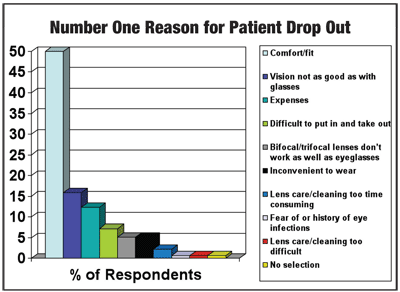 What is one contact lens patient worth to your practice? If you answered, “A fitting fee and a year’s supply of lenses,” you’re missing the point!
What is one contact lens patient worth to your practice? If you answered, “A fitting fee and a year’s supply of lenses,” you’re missing the point!
I hear it all the time. Patients tell me, “The last doctor said he couldn’t fit me with contact lenses because of my astigmatism.” Or, “The last doctor just couldn’t find a comfortable pair of contact lenses for me.” Or, “I was told that monovision or bifocal contacts are just not the best option, but a nice pair of spectacles will get the job done.” I cringe when I hear these statements. Both established and new practitioners must realize that in order to grow 10% net for the year, they have to increase new patients by 30% to account for approximately 20% of the contact lens dropouts.1 In our practices, we should always be focusing on how to decrease the number of dropouts and increase our bottom line.
The number one reason for a patient to drop out of lens wear is poor comfort or fit.2 Some patients have reported as many as two hours of uncomfortable wearing time throughout their day.3 Currently, about 60% of new fits or refits in the U.S. are silicone hydrogel lenses.4
As eye care practitioners, we are doing a great job educating our patients about these newer, more breathable silicone hydrogel lenses, but we need to go the extra step and educate them on different solution technologies that match these superb lens advancements. Studies have illustrated enhanced comfort for symptomatic patients who were upgraded to a POLYQUAD®/ALDOX® solution.3-6

Top eye care provider reasons for contact lens wear dropout were discomfort (50%), poor vision (16%) and expense (12%).1
A recent study conducted by John Rumpakis, O.D., M.B.A., examined the lost revenue from just one contact lens dropout in a practice. He found that the cost of a dropout was around $24,000 over the lifetime of a practice. For example, say you have 1,000 contact lens wearers in your practice. A dropout rate of 20% for those 1,000 patients yields 200 patients lost per year. When you take 200 patients and multiply that number by $24,000, that equates to $4.8 million over the life of your practice. In conclusion, recommending the correct solution to your patients will yield many benefits over the course of a practice lifetime, and your patients will thank you for their newfound comfort!
This column is sponsored by Alcon.
1. Rumpakis JMB. New data on contact lens dropouts: an international perspective. Rev Optom. 2010 Jan;147(1):37-42.
2. Zigler L, Cedrone R, Evans D, et al. Clinical evaluation of silicone hydrogel lens wear with a new multipurpose disinfection care product. Eye Contact Lens. 2007 Sep;33(5):236-43.
3. Nichols JJ. Annual report: contact lenses 2009. Contact Lens Spectrum. 2010 Jan;25(1):20.
4. Lin MC, Tatyana TF. Differences in protein-removal efficiency among multi-purpose solutions. Paper # 2020 presented at: Association for Research in Vision and Ophthalmology; April 28, 2008; Ft. Lauderdale, FL.
5. Young G, Keir N, Jones S. Clinical evaluation of long-term users of two different contact lens care preservative systems. Poster presented at: BCLA; May 2008; Birmingham, UK.
6. Corbin GS, Bennett L, Espejo L, et. al. A multicenter investigation of OPTI-FREE® RepleniSH® multi-purpose disinfecting solution impact on soft contact lens patient comfort. Clin Ophthalmol. 2010 Feb 2;4:47-57.


